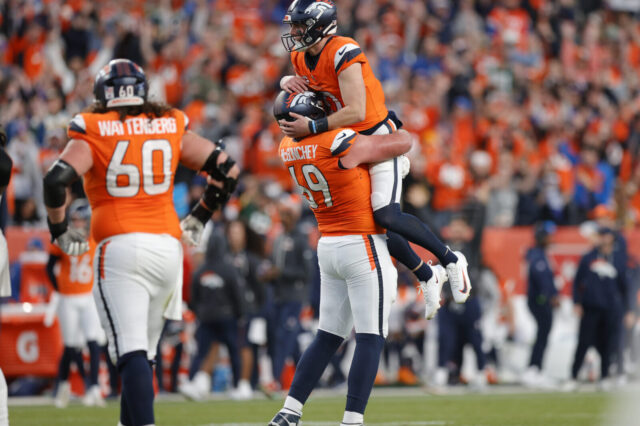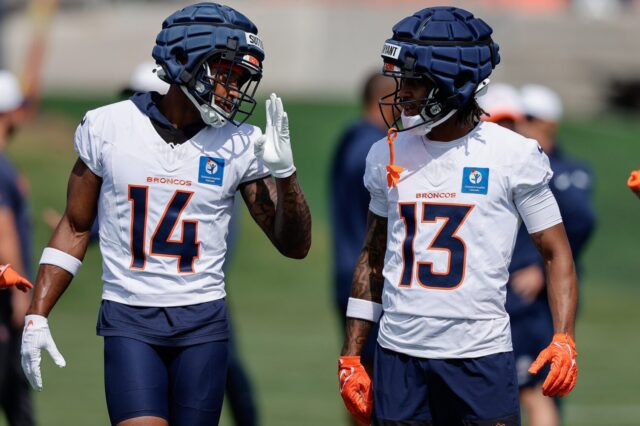In the coming weeks, the Broncos have a lot of work to do. Prior to the NFL’s free agency period beginning on March 10, and well before the league’s annual draft commences on April 30, the team has a lot of decisions to make with regard to their roster.
Obviously, the pending hole at quarterback should Peyton Manning choose not to return would be atop the list. But even if No. 18 plays again in 2015, which most people expect him to do, there are still a lot of other question marks. Currently, Denver has 13 unrestricted and seven restricted free agents that may not return next season; that’s a huge percentage of a roster that went 12-4 and won the AFC West last year.
As the Broncos put together their priority list, knowing that not everyone can return, some decisions are relatively easy. High-priced veterans like Wes Welker won’t return, while players who have fallen out of favor with the team, such as tight end Julius Thomas, will probably have to find them elsewhere. Meanwhile, promising youngsters, like Brandon Marshall and Nate Irving, will probably be retained, while unheralded contributors like Virgil Green will also most likely be back.
But other choices are going to be very, very difficult. Orlando Franklin is a versatile offensive lineman, someone who brings a much-needed dose of nastiness to the trenches; but he struggled in 2015 after making the move from tackle to guard. Rahim Moore is an athletic, talented safety; but it might be best for the player who infamously blew the Ravens game in the 2012 playoffs to get a fresh start elsewhere.
And then things get really tricky. Because if the Broncos are truly intent on spending their money wisely, they’ll make two unpopular decisions: They’ll choose to let Demaryius Thomas and Terrance Knighton sign mega-contracts elsewhere.
While that notion might sound ludicrous, the cold, hard facts would support both moves. Wide receiver and defensive tackle aren’t smart places to make large investments.
The 10 wide receivers with the biggest cap hits in 2014 had a grand total of one Super Bowl ring between them; Marques Colston won a title with the Saints in 2009. That’s it. The rest – Mike Wallace, Andre Johnson, Calvin Johnson, Vincent Jackson, Dwayne Bowe, Pierre Garcon, Brandon Marshall, Larry Fitzgerald and Welker – have never hoisted the Lombardi Trophy during their careers.
Instead, Super Bowl-winning teams tend to have somewhat pedestrian receiving corps. Of the past 10 NFL champions, only two – the Colts in 2006 (Marvin Harrison) and the Packers in 2010 (Greg Jennings) – have boasted a Pro Bowl wideout on their title-winning roster. The rest have featured leading receivers like Hines Ward, Victor Cruz, Anquan Boldin, Golden Tate and Julian Edelman; those are all very good players, but none were regarded among the best pass catchers in the league during their title-winning campaign.
And this year’s Super Bowl continued this trend.
After winning the title in 2013, the Seahawks considered wide receiver such an insignificant position that they let their leading receiver (Tate) leave via free agency and jettisoned their most-explosive player (Percy Harvin) to the Jets. Instead, they were content to go with the likes of Doug Baldwin, Jermaine Kearse, Ricardo Lockette and Chris Matthews; and they got within one yard of winning a second-consecutive championship.
On the other sideline on Super Sunday, the Patriots featured a similarly anonymous group of receivers. Danny Amendola, Julian Edelman and Brandon LaFell aren’t exactly a star-studded cast. But after failing to win a title with players like Randy Moss and Wes Welker on the roster, Bill Belichick went back to the type of receivers who had helped New England win three Super Bowls in the early 2000s – guys like Deion Branch, Troy Brown, David Givens and David Patten.
So how on earth is investing $13 million in Thomas in 2015 via the franchise tag, or $100 million across the next six or seven years if he inks a long-term deal, a smart move? That’s nearly 10 percent of the salary cap, dedicated to a player where there’s no correlation between putting money into that position and winning a championship.
A similar argument can be made for defensive tackles. Other than Haloti Ngata and Vince Wilfork, the 10 most-expensive (based on cap numbers) players at that position in 2014 have never helped their team win much of anything. Ndamukong Suh, Gerald McCoy, Geno Atkins, Ahtyba Rubin, Barry Cofield, Linval Joseph, Marcell Dareus and Kyle Williams combined to count $80 million against their respective team’s salary caps last year; they also combined to win a collective zero playoff games.
Some of these guys posted monster numbers, as Suh, McCoy, Dareus and Williams at least earned their paychecks from a statistical standpoint. But the other half of the list didn’t, proving to be bad investments because of injury, lack of production or a combination of both.
Unfortunately for Knighton, he’s more like Atkins, Cofield, Joseph and Rubin in terms of numbers; in 2014, the defensive tackle only managed 19 tackles and two sacks. That’s a far cry from what the NFL’s most productive players at defensive tackle posted, as Dareus had 10 sacks, McCoy and Suh each recorded 8.5, and Williams chalked up 5.5.
Thus, an argument can be made that Knighton doesn’t even deserve a big contract; he certainly doesn’t have the numbers to justify it. In fact, his production isn’t that much different than that of teammate Sylvester Williams – 18 tackles and zero sacks – a player most would consider a bust after two seasons in the league.
Proponents of Knighton will argue that it’s hard to quantify his impact via numbers; his job is about taking up space, occupying blockers and being disruptive in the backfield – three things that don’t show up on the stat sheet. That contention only holds water if other defensive tackles aren’t asked to do the same things, but they are; and they still find a way to get to the quarterback and tackle runners.
If that’s not enough, consider the flame-out factor. Because of their size, defensive tackles have a hard time staying healthy; the human body simply isn’t designed to carry 300-plus pounds on a 6-foot frame. As a result, wear and tear has an impact after a couple of seasons, and injuries start to set in. That’s why it’s rare to see a defensive tackle post multiple productive seasons in a row.
Ngata is a good example. The past two seasons, as he’s approached the age of 30, his production has tailed off tremendously. In 2013 and ’14 combined, the Ravens defensive tackle posted just 3.5 total and 43 tackles – total, across two seasons. With Knighton turning 29 in July, it’s not hard to project a similar decline in play.
And for another concern, throw in the fact that the popular defensive tackle, who goes by the nickname “Pot Roast” because of his love of a good meal, has battled weight issues. During his two seasons in Denver, he’s reportedly been fined repeatedly for tipping the scales too far. And last season, it appeared as though the Broncos equipment managers gave up on trying to find him a jersey that fit; by year’s end, his No. 98 barely covered half his torso. That’s not exactly a recipe for staying healthy, productive and on the field.
So how does it make sense to offer a big-money, multi-year deal to Knighton? Based on history, it’s more than likely going to turn out to be a bad investment.
During his time in Denver, John Elway has proven that he’s willing to make the tough decisions. He parted ways with Elvis Dumervil and Tim Tebow, let Eric Decker and Knowshon Moreno depart via free agency, canned John Fox after four straight AFC West titles, and is reportedly asking Manning to take a pay cut. Those moves took some guts.
But those were just warm-up exams. The real test is about to come. It’ll be interesting to see if Elway has the gumption necessary to say goodbye to a pair of popular players, guys who simply aren’t worth big-money contracts.



